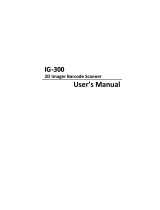
ii
3.3.7. Options for IATA .............................................................................................. - 42 -
3.3.8. Options for MSI/Plessey .................................................................................... - 42 -
3.3.9. Options for Telepen ........................................................................................... - 44 -
3.3.10. Options for UK/Plessey ................................................................................... - 45 -
3.3.11. Options for Code 128 and GS1-128 ................................................................ - 45 -
3.3.12. Options for Code 93 ........................................................................................ - 47 -
3.3.13. Options for Code 11 ........................................................................................ - 48 -
3.3.14. Options for Korean Postal Authority code ...................................................... - 49 -
3.3.15. Options for Intelligent Mail Barcode ............................................................... - 50 -
3.3.16. Options for POSTNET .................................................................................... - 51 -
3.3.17. Options for GS1 Databar ................................................................................. - 51 -
3.3.18. Options for Composite Codes.......................................................................... - 53 -
3.3.19. Options for Codablock F ................................................................................. - 55 -
3.3.20. Options for DataMatrix ................................................................................... - 55 -
3.3.21. Options for Aztec ............................................................................................ - 57 -
3.3.22. Options for Chinese Sensible code .................................................................. - 58 -
3.3.23. Options for QR Code ....................................................................................... - 59 -
3.3.24. Options for Micro QR Code ............................................................................ - 60 -
3.3.25. Options for Maxicode ...................................................................................... - 61 -
3.3.26. Options for PDF417 ........................................................................................ - 62 -
3.3.27. Options for MicroPDF417 ............................................................................... - 63 -
4. STRING OPTIONS ......................................................................................................... - 65 -
4.1. Case conversion ........................................................................................................ - 65 -
4.2. Set prefix and suffix ................................................................................................. - 66 -
4.2.1. Set prefix ........................................................................................................... - 73 -
4.2.1.1. Direct input keyboard keys ................................................ - 73 -
4.2.1.2. Direct input numeric .......................................................... - 77 -
4.2.1.3. Direct input character ......................................................... - 78 -
4.2.1.4. Direct input lower case character ....................................... - 80 -





















